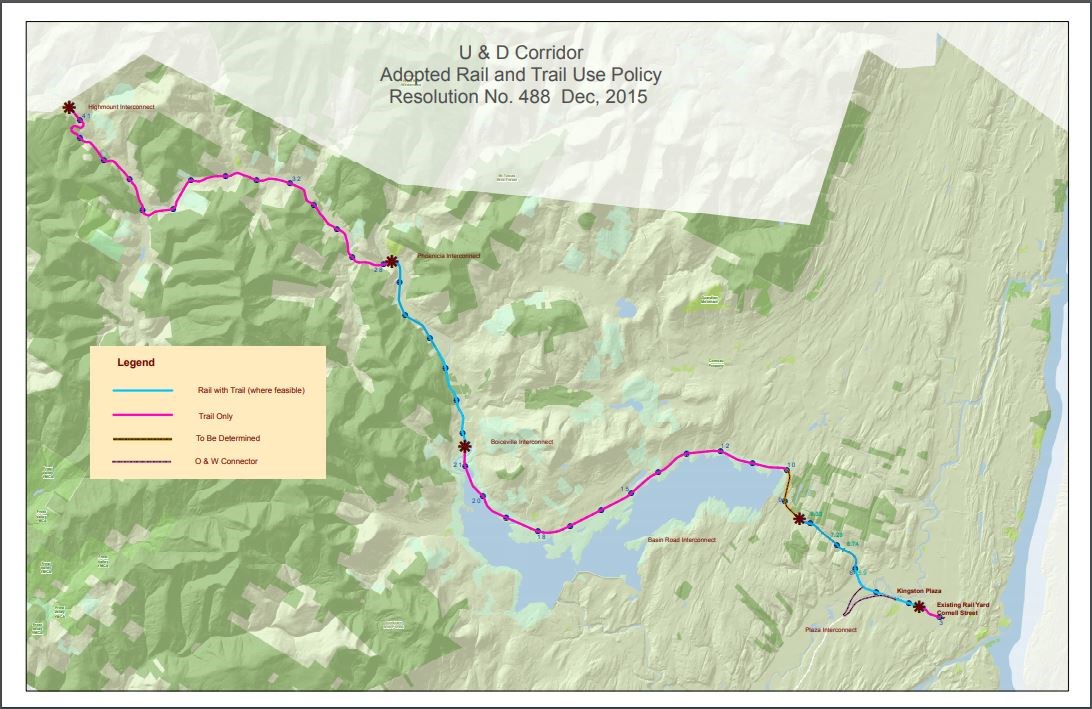Last updated: March 2, 2022
Article
From Rails to Trails: Connecting a Community to its Outdoors

Story by Kendra Barat
When 17 percent of households do not own a vehicle within a car-centric city, alternative modes and routes of transportation are crucial.
An Equity Issue
Kingston, New York, the major city of Ulster County, is experiencing what Karl Beard, a project specialist for the National Park Service – Rivers, Trails and Conservation Assistance Program, calls a “social equity issue” when it comes to safe recreation and transportation.
Ulster County is a made up of 24 towns and one city situated west of the Hudson River, approximately 100 miles north of New York City. Plans have been in place for many years to complete a county-wide trail network that would convert inactive railroad corridors into trails to connect communities.

As part of their efforts, the Ulster County Office of Economic Development enlisted the assistance of the National Park Service to help refine their plans related to transportation and recreation along the city’s multiple abandoned railroad corridors.
According to Beard, the city asked him to assist with the “broader vision” of connecting the urban corridors to the wider rail-trail network throughout the county.
“We could be the rail-trail hub,” said Kevin Smith, co-chair of the Friends of the Catskill Mountain Rail Trail committee and the chairman of Woodstock Land Conservancy, both long-standing stakeholders and influencers in the county project.
In 2017, New York governor Andrew Cuomo allocated $200 million of state funding to link existing trails and construct the Empire State Trail by 2020. When complete, the 750-mile continuous multi-use trail will connect New York City to Canada and Albany to Buffalo, becoming the longest trail of its kind in the state of New York.
When plans for the Empire State Trail were revealed, conservation and recreation stakeholders in Ulster County agreed to align their efforts with this larger state project. The proposed trail route would follow the already developed Hudson Valley Rail Trail from Poughkeepsie, connect with the Wallkill Valley Rail Trail and run directly into the city of Kingston.

A Way to Connect Communities
According to Smith, it would be ideal to bring “people into the city [of Kingston] for tourism and possible commuting, but also for people in the city to have really easy-ready access to remarkable places just outside of the boundaries of the city.”
Since the start of the National Park Service’s involvement in the Ulster County Rail Trail Project, Beard has helped create community engagement strategies, helped start a local committee to create a management plan for incomplete sections of the trail and has advised planners, consultants and community groups on trail design.
Beard’s technical assistance has “helped move forward the vision in Ulster County from an idea, to a vision, to an actual plan,” said Smith.
As the only city in the county, converting railroads to trails in Kingston has become a focal point for planners. To garner public and political support in the city, Beard along with representatives from the Friends of the Catskill Mountain Rail Trail committee and a host of other community groups are making the case for safety.
Reimaging Recreation Spaces
According to Smith, there is a severe lack of parks in midtown Kingston. “A park desert,” as he calls it. The prospect of providing residents with a linear park, a place to safely travel and recreate, is an exciting one.
Chris White, the deputy director of the Ulster County Planning Department, said Kingston has long suffered from neglect and blight but is enthusiastic of the trail project in place.
"The city will see tangible benefits of these rail-trails as place to safely play, walk and move from place to place in and around the city.” – Chris White, Ulster County Planning Department Deputy Director
“They need a park!” a social worker at Kingston High School said in reference to the proposed linear park through the center of the city. Her experience with the youth of Kingston led her to believe that young residents need a safe place to recreate that may help keep them busy and out of trouble.

“More people than not want to see this unused corridor become an active transportation corridor as opposed to a fallow railroad that just continues to deteriorate,” said White.
This connection of rail-trails would enhance safe access to important city destinations such as the Kingston Plaza shopping center, Kingston Point Park and Kingston High School. By leveraging funding and planning from the Empire State Trail project along with National Park Service assistance, the Ulster County Rail Trail Project has found significant backing.

Optimistic About the Future
Moving forward, the National Park Service looks to help figure out "how to organize on a regional basis to promote a sustainable form of stewardship, monitoring maintenance, promotion, trail ambassadorship and provide a level standard of service for all of these trails," said Beard.
According to Smith, the “forward-looking assistance” that the National Park Service provides allows the Ulster County Rail Trail Project to become a state priority. Ultimately the goal of both the Ulster County network and the Empire State Trail is to “provide people with really quality opportunities to experience everything that New York state has to offer.”
